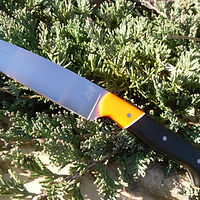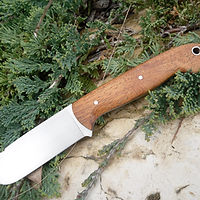
ABOUT
Knives have always been a passion of mine since childhood. I remember my grandfather teaching me how to sharpen knives using old Arkansas stones, and I sitll have a small transluscent Arkansas stone that he gave me when I was in 8th grade. Knives are a tool, and there is simply nothing like using the right tool for the job. Making these tools is even more fun than using them! I've been turning knives out for the past 4 years, starting in 2012.
What makes a custom knife better than many commercially available products? Three things. Geometry, heat treatment, and steel selection. In that order. Roman Landes, a well known German knife maker and metallurgist said it well, "Geometry cuts, heat treatment determines how long." Geometry is the biggest factor in how a knife performs. Notice your straight razor has a completely different geometry than the axe in the barn. Two different tasks, two different geometries. Thin is in, as we say. Most of my knives are built as slicing instruments, and as such the geometry is tailored for each application. You will not find thick edges on my knives, nor thick spines. Most knives from the major companies are overbuilt, and this is reasonable, as often knives are pressed into services other than their design calls for. My kitchen knives and hunting knives will have an edge that is approximately .005" before sharpening. Many store bought kitchen knives are .030" or more!
Heat treatment is one of my favorite parts of the knife making process. Using a digitally controlled kiln, I am able to harden each steel according to it's specifications to an exact hardness. Precise temperature control is a must with many of the modern alloys. The quench medium I use is Parks 50 quench oil, a fast oil that can be used with many of the carbon steels available today. If the alloy calls for it, a sub zero dry ice quench is used prior to tempering, or even liquid nitrogen, depending on the steel being used. Tempering is extremely important, and depending on the knife and it's application, I can dial in a precise Rockwell hardness. The more I learn about heat treating, the less I realize I know.
Steel is a critical component, but not as important as geometry and heat treating. I use only virgin carbon steel, and some stainless like AEB-L, all sourced from knife making steel suppliers. I do not, and will not, use mystery steel. If I don't know what it is, I can't heat treat it properly. My preference is carbon steel, it's easier to sharpen and takes a finer edge with greater ease than many stainless steels. I often use 1084, 1095, 52100, O1, O7, Blue 2, W2, 15n20, and Cru Forge V. CPM M4 is a favorite as well, and as far as stainless goes, AEB-L, developed for the razor industry, is great steel. It is often called "the stainless steel that behaves like carbon steel", because it is easy to sharpen. Basically, all the benefits of carbon steel, with the benefits of being rust/stain resistant.
Natural wood is my handle material of choice, Walnut being a classic favorite. Mequite, Ebony, Rosewood, you name it, I will use it! G10, while not possessing as much character as wood, is extremely durable, and often recommended when hard use or corrosive environments might otherwise damage a wood handle.
Putting these three together, proper geometry for the task at hand, the best steel available, and the best heat treatment for the given steel, provides for a superb cutting instrument, one that will be a real pleasure to use, and to pass along to the kids and grandkids!
Stuart Davenport
512.618.3285
San Antonio, Texas

Black G10 Hunter, O7 tool steel
This knife is an example of ultimate performance. O7 tool steel with an extremely thin grind. Talk about unzipping that buck you just shot...

Orange and Black G10 52100 bearing steel
My first experiment with two tone handle. Blaze orange G10, Black G10, White G10 spacer.

Round nose calf cutter O1 tool steel
A good friend of mine asked for a custom round nose knife. He explained that the round nose was necessary when "cutting" calves. A point would get in the way, cutting bits that shouldn't be! Sporting a mesquite wood handle.


